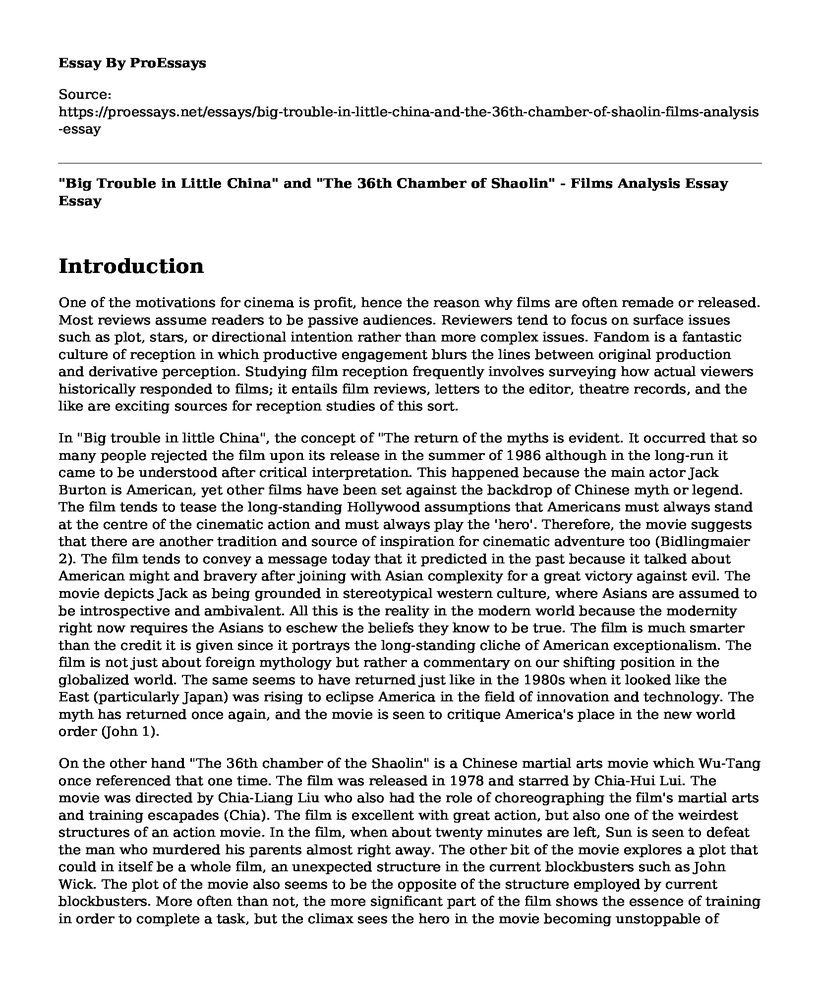Introduction
One of the motivations for cinema is profit, hence the reason why films are often remade or released. Most reviews assume readers to be passive audiences. Reviewers tend to focus on surface issues such as plot, stars, or directional intention rather than more complex issues. Fandom is a fantastic culture of reception in which productive engagement blurs the lines between original production and derivative perception. Studying film reception frequently involves surveying how actual viewers historically responded to films; it entails film reviews, letters to the editor, theatre records, and the like are exciting sources for reception studies of this sort.
In "Big trouble in little China", the concept of "The return of the myths is evident. It occurred that so many people rejected the film upon its release in the summer of 1986 although in the long-run it came to be understood after critical interpretation. This happened because the main actor Jack Burton is American, yet other films have been set against the backdrop of Chinese myth or legend. The film tends to tease the long-standing Hollywood assumptions that Americans must always stand at the centre of the cinematic action and must always play the 'hero'. Therefore, the movie suggests that there are another tradition and source of inspiration for cinematic adventure too (Bidlingmaier 2). The film tends to convey a message today that it predicted in the past because it talked about American might and bravery after joining with Asian complexity for a great victory against evil. The movie depicts Jack as being grounded in stereotypical western culture, where Asians are assumed to be introspective and ambivalent. All this is the reality in the modern world because the modernity right now requires the Asians to eschew the beliefs they know to be true. The film is much smarter than the credit it is given since it portrays the long-standing cliche of American exceptionalism. The film is not just about foreign mythology but rather a commentary on our shifting position in the globalized world. The same seems to have returned just like in the 1980s when it looked like the East (particularly Japan) was rising to eclipse America in the field of innovation and technology. The myth has returned once again, and the movie is seen to critique America's place in the new world order (John 1).
On the other hand "The 36th chamber of the Shaolin" is a Chinese martial arts movie which Wu-Tang once referenced that one time. The film was released in 1978 and starred by Chia-Hui Lui. The movie was directed by Chia-Liang Liu who also had the role of choreographing the film's martial arts and training escapades (Chia). The film is excellent with great action, but also one of the weirdest structures of an action movie. In the film, when about twenty minutes are left, Sun is seen to defeat the man who murdered his parents almost right away. The other bit of the movie explores a plot that could in itself be a whole film, an unexpected structure in the current blockbusters such as John Wick. The plot of the movie also seems to be the opposite of the structure employed by current blockbusters. More often than not, the more significant part of the film shows the essence of training in order to complete a task, but the climax sees the hero in the movie becoming unstoppable of modern action cinema (Desser 146). This is quite interesting, but then the film offers low stakes training and no real threat in the final scenes as expected.
The structure of this film is hardly perfect. In as much as the villain is eliminated, this happens so quickly. It is, however, an interesting contrast when compared to the current blockbusters because in a movie like "John Wick", we do not find the star of the movie is not seen to spend time training for years to eliminate his enemies. So "The 36th chamber of Shaolin" becomes interesting because it manages to entertain its audience by making up for a few flaws (shows the training scenes) depicted in current blockbusters. Current blockbusters rarely account for such scenes.
Works Cited
Bidlingmaier, Selma Siew Li. "The Spectacle of the Other: Representations of Chinatown in Michael Cimino's Year of the Dragon (1985) and John Carpenter's Big Trouble in Little China (1986)." Current Objectives of Postgraduate American Studies 8 (2007).
Chia-Liang, Liu. "The 36th Chamber of Shaolin." (1978).
Desser, David. "Diaspora and National Identity: exporting'China'through the Hong Kong cinema." Transnational Cinema: the film reader (2006): 143-155.
John Kenneth Muir. " CULT MOVIE REVIEW: Big Trouble in Little China(1986)." (2005). Retrieved from https://johnkennethmuir.wordpress.com/2012/04/03/cult-movie-review-big-trouble-in-little-china-1986/
Cite this page
"Big Trouble in Little China" and "The 36th Chamber of Shaolin" - Films Analysis Essay. (2022, Dec 05). Retrieved from https://proessays.net/essays/big-trouble-in-little-china-and-the-36th-chamber-of-shaolin-films-analysis-essay
If you are the original author of this essay and no longer wish to have it published on the ProEssays website, please click below to request its removal:
- Music Therapy and Effects of Music on Psychological and Mental Health
- Editor's Visions on the Book Single Star of the West: The Republic of Texas Paper Example
- Movement of Painting of Photography: Annotated Bibliography
- Michael Radford's "1984" and George Orwell's "Nineteen Eighty-Four" Essay
- The Psychology of Music Essay
- Essay Sample on Pre-Colonial Art: Asian vs African Expression
- Rennie Harris Pure Movement: Emphasizing Essence of Street Dance - Essay Sample







